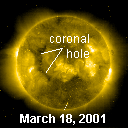|   SPACE WEATHER SPACE WEATHER
Current
Conditions
Solar Wind
velocity: 315.6 km/s
density:3.1 protons/cm3
explanation | more data
Updated: Today at 2154 UT
X-ray Solar Flares
6-hr max: C1 1730 UT Mar18
24-hr: C3 0745 UT Mar18
explanation | more data
Updated: Today at 2250 UT
Daily Sun: 18 Mar '01 
Sunspot group 9373 has a complex beta-gamma magnetic field that harbors energy for M-class solar flares.
Sunspot Number: 90
More about sunspots
Updated: 17 Mar 2001
Radio Meteor Rate
24 hr max: 28 per hr
Listen to the Meteor Radar!
Updated: 16 Mar 2001 Interplanetary Mag. Field
Btotal: 5.0 nT
Bz: 2.3 nT south
explanation | more data
Updated: Today at 2155 UT Coronal Holes:

This narrow coronal hole could send a gust of solar wind toward Earth on Tuesday when it crosses the Sun's central meridian. Image credit: SOHO Extreme UV Telescope.
More about coronal holes
 SPACE WEATHER SPACE WEATHER
NOAA
Forecasts
Solar Flares: Probabilities for a medium-sized (M-class) or a major (X-class) solar flare during the next 24/48 hours are tabulated below.
Updated at 2001 Mar 18 2200 UT
| FLARE | 24 hr | 48 hr | | CLASS M | 25 % | 25 % | | CLASS X | 01 % | 01 % |
Geomagnetic Storms: Probabilities for significant disturbances in Earth's magnetic field are given for three activity levels: active, minor storm, severe storm
Updated at 2001 Mar 18 2200 UT Mid-latitudes | 24 hr | 48 hr | | ACTIVE | 15 % | 15 % | | MINOR | 10 % | 10 % | | SEVERE | 01 % | 01 % |
High latitudes | 24 hr | 48 hr | | ACTIVE | 25 % | 25 % | | MINOR | 10 % | 10 % | | SEVERE | 05 % | 05 % |
| What's Up in Space -- 18 Mar 2001
Subscribe to Space Weather News! ALL QUIET, FOR NOW: Active region 9373, the largest sunspot group on the solar disk, has a twisted beta-gamma magnetic field that harbors energy for possible M-class flares. Nevertheless, solar activity has been low for days and it seems likely to continue so. HERE COMES MIR: On March 22, 2001, the Russian Space Agency will ignite the engines of a Progress rocket attached to Mir and send the 135-ton space station to a watery grave in the remote south Pacific. The space station will join a surprising parade of Mir-sized objects that hit Earth every year. [Full Story] WEB LINKS: NOAA FORECAST | GLOSSARY | SPACE WEATHER TUTORIAL | LESSON PLANS | BECOME A SUBSCRIBER | 
Potentially Hazardous Asteroids (PHAs) are space rocks larger than ~100m that can come closer to Earth than 0.05 AU. None of the known PHAs are on a collision course with our planet, although astronomers are searching for and discovering new ones all the time.
On 18 Mar 2001 there were 290 known Potentially
Hazardous Asteroids Upcoming Encounters (March 1 - April 30, 2001) | Object | Date (UTC) | Miss Distance | | 2000 PN9 | 2001-Mar-02 17:29 | 0.0610 AU | | 1998 SF36 | 2001-Mar-29 18:37 | 0.0383 AU | | 1986 PA | 2001-Apr-03 01:06 | 0.1465 AU | | 2000 EE104 | 2001-Apr-12 20:37 | 0.0822 AU | 
- TOTAL LUNAR ECLIPSE: On Jan. 9, 2001, the full Moon glided through Earth's copper-colored shadow. [gallery]
- CHRISTMAS ECLIPSE: Sky watchers across North America enjoyed a partial solar eclipse on Christmas Day 2000 [gallery]
- LEONIDS 2000: Observers around the globe enjoyed three predicted episodes of shooting stars. [gallery]
 Feb. 21, 2001: Nature's Tiniest Space Junk -- Using an experimental radar at the Marshall Space Flight Center, scientists are monitoring tiny but hazardous meteoroids that swarm around our planet. Feb. 15, 2001: The Sun Does a Flip -- NASA scientists who monitor the Sun say our star's enormous magnetic field is reversing -- a sure sign that solar maximum is here. Jan. 25, 2001: Earth's Invisible Magnetic Tail -- NASA's IMAGE spacecraft, the first to enjoy a global view of the magnetosphere, spotted a curious plasma tail pointing from Earth toward the Sun. Jan. 4, 2001: Earth at Perihelion -- On January 4, 2001, our planet made its annual closest approach to the Sun. Dec. 29, 2000: Millennium Meteors -- North Americans will have a front-row seat for a brief but powerful meteor shower on January 3, 2001. Dec. 28, 2000: Galileo Looks for Auroras on Ganymede -- NASA's durable Galileo spacecraft flew above the solar system's largest moon this morning in search of extraterrestrial "Northern Lights" Dec. 22, 2000: Watching the Angry Sun -- Solar physicists are enjoying their best-ever look at a Solar Maximum thanks to NOAA and NASA satellites. MORE SPACE WEATHER HEADLINES |



